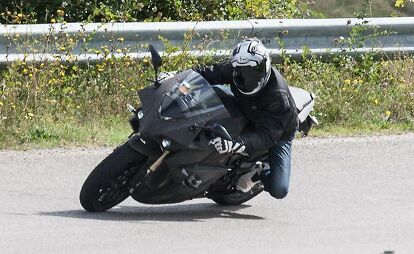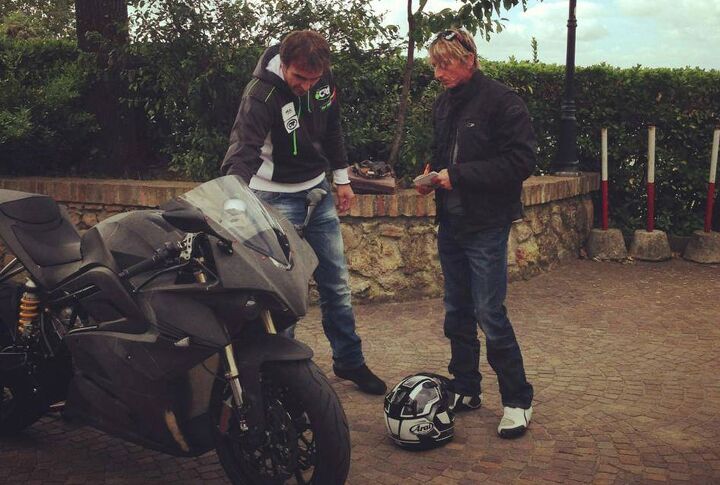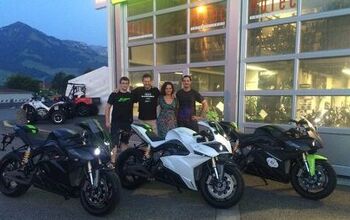2015 Energica Ego Review – First Ride
Riding the prototype of Italy's first electric sportbike
Forget the golf cart analogies; Energica’s Ego is a bona fide sportbike that just happens to be powered by electricity.
2015 Energica Ego
| Engine | 18/20 |
| Suspension/Handling | 12/15 |
| Transmission/Clutch | 9.5/10 |
| Brakes | 9/10 |
| Instruments/Controls | 5/5 |
| Ergonomics/Comfort | 7/10 |
| Appearance/Quality | 8.5/10 |
| Desirability | 9/10 |
| Value | 8/10 |
| Overall Score | 86/100 |
But where did this come from? The new Energica brand is an offshoot of CRP (Cevolini Rapid Prototyping) Group, a relatively obscure company unless you’re in the business of Formula One. Several top F1 teams are regular customers of CRP, which is based in Ferrari’s backyard of Modena, Italy.
CRP specializes in working with exotic materials, with a high-tech CNC-machining enterprise and a facility that performs bleeding-edge 3-D printing using a laser-sintering process and its proprietary Windform materials. CRP’s 40 years in motorsport is now being augmented by CRP USA, which is based in Mooresville, North Carolina, in the heart of NASCAR country, to serve its customers.
More recently, CRP is expanding into the aerospace realm and, more pertinent to us, its new business of creating an electric-powered sportbike. The Energica Ego is the first e-sportbike to emerge from Italy, and Motorcycle.com was invited to ride the prototype overseas in advance of the production bike’s release scheduled for 2015.
The Ego follows the exploits of the eCRP 1.4, a racer that competed in the TTXGP series during 2010 and 2011, finishing runner-up in the 2011 world championship. But the EGO streetbike is much more potent and shares few commonalities with the eCRP, which trades its aluminum frame for a tubular steel-trellis one and less-powerful DC motors for AC power.
Energica is using the “superbike” descriptor for its new sports machine, and that’s backed up by eye-popping claims for the power figures from its permanent magnet AC motor. It’s rated at 134 horsepower that’s said to be available from 4900 to 10,500 rpm. But electric motors are more notable for their incredible torque – the Ego is said to twist out a monstrous 144 ft-lb from 0 to 4700 rpm. Oil-cooling helps shed heat generated by that much power.
The motor isn’t the only component needing to expel heat, as a traditional radiator is used to cool the Ego’s power electronics – the system tasked with converting direct current (DC) energy from the battery to alternating current for the AC motor.
As for the battery, it has a nominal capacity of 11.7 kilowatt-hours, which is 1.4 kWh more than the optional battery pack in the Zero S and 2.1 kWh more than the Brammo Empulse. As for who makes the Ego’s batteries, that won’t be released until this fall’s EICMA show, although we did learn they will be sourced from somewhere in Asia’s Pacific Rim. Energica claims a range of 93 miles.
A 3kWh charger will be mounted on the production bike, which will allow a full charge in a claimed three hours when using a 220-volt power supply. If you have access to a DC fast charger, such as the ones using America’s recent SAE Combo-1 standard, Energica says an 80% charge will take just 30 minutes. Egos destined for the streets of Europe will use the similar (different coupler) Combo-2 standard. SAE Combo charging currently can deliver up to 50 kw of juice per hour, and it’s projected to bump up near 80 kw/h sometime next year.
The rest of the mechanical bits are more familiar, and in many ways identical to Brammo’s Empulse R. A 43mm Marzocchi inverted fork and Sachs shock, both three-way adjustable, will comprise the suspension (an Ohlins shock was fitted to the prototype we rode). The rear is actuated by a cast-aluminum swingarm. Marchesini provides wheels; lightweight forged-aluminum hoops. Brakes are from Brembo, with monobloc radial-mount calipers pinching a pair of 320mm wave rotors up front. ABS wasn’t present on the prototype we rode, but it will be standard equipment on the production EGO.
The Ride
Volterra, Italy, was an inspired choice for the location of Energica’s test ride. It’s been a city since before Jesus, and it was the birthplace for one of the first internal combustion engines (ICE). Plus, in relation to this electric sportbike, it has “Volt” in its name!
The Ego prototype we’d be riding wore bodywork made up of a collection of 3-D-printed panels bonded together in a stealth-fighter-like cloak. Production bikes will employ panels made from plastic, which is more efficient to produce in larger quantities.
Like so many Italian sportbikes before it, the Ego has a committed riding position. Its bars mounted too low to be comfortable on the street, but the clamps were located about one inch lower than the upper triple clamp, giving enough latitude to raise them without any changes in specifications. Unlike some previous Italian sportbikes, the EGO has a generous 34-degree steering sweep, so it’s maneuverable even within the confines of 2000-year-old city streets. Its 31.9-inch seat is fairly narrow and is a bit short on fore/aft room.
“Throttle” response from some e-bikes can feel disconnected and unnatural, but the Energica’s is exceedingly refined for a prototype. In fact, I’d say it’s production-ready now. As is, reactions at slow speeds are perfectly intuitive, delivering exactly what a wrist is asking for. (I’ve always been amused to read reports of e-bikes in other publications that state they have ride-by-wire throttles. What else would an electric motor use?!)
Dialing in bigger throttle inputs (the last third of rotation) taps in to the hefty grunt of the electric motor, effortlessly gathering up speed with a vast surge that feels almost like a 1200cc Twin in the meat of its powerband. CRP engineers describe it as relating closest to a turbo-diesel engine. But its power production – mostly unrelated to engine speed – isn’t really comparable to any ICE.
The Ego’s motor controller is programmed to send full torque only once past about 10 mph. Considering the massive torque claims, the Ego was surprisingly reluctant to wheelie. I was only able to loft the front wheel a few inches above flat ground, but I was able to pull a decent floater over a crest in the road at about 40 mph. Its motor is able to spin up to 12,000 rpm, but is electronically limited to 10,500 rpm.
Regenerative braking comes into play with the twistgrip fully closed, feeding electricity back into the batteries, but it’s thankfully free of excessive engine braking-abruptness that can upset a chassis. Also nicely tuned is a usable neutral spot in the throttle freeplay area that allows coasting without unwanted motor braking. The production bike will offer fine-tuning of motor-control responses.
Although an exhaust note is naturally not part of the experience, the Energica definitely is not silent. Power is routed through straight-cut gears that pleasingly sing at various pitches depending on road speeds – at times sounding a bit like a “Star Wars” Tie Fighter, emitting a powerful shriek. Interestingly, CRP engineers say the direct-drive gearing has a ratio similar to fourth or fifth gear in a Yamaha R1, but it’s pulled easily by its commanding electric motor.
Considerable mass somewhat hinders the EGP’s slow-speed handling – big batteries and a powerful motor are inevitably heavy, which adds up to 569-pounds of vehicle weight. But before you scoff, you should know that the EGO feels more like a dense 600cc supersport than its weight would imply. Credit the forged wheels and far less gyroscopic forces from a reciprocating internal combustion engine spinning at 5000 or 10,000 rpm.
Enrico Zelioli, former project leader of Husqvarna’s Nuda, joined the Energica team at the beginning of this year. After testing the early prototype, he made changes to slightly raise the bike’s center of gravity to aid quicker steering transitions and greater longitudinal weight transfer, the latter helping enhance the bike’s strong front-end feel.
Other than its powerplant, the Ego functions like a traditional motorcycle. Its Brembo brakes offer good power and feel via its radial-pump master cylinder. The Marzocchi fork is dialed in, but the direct-action shock (rather than via a linkage) felt oversprung for my weight and relatively crude in comparison with the best sportbikes. Switchgear is by Domino, as used on Guzzi/Aprilia.
Our route consisted mostly of aggressive riding on Tuscany’s hilly and twisty secondary roads, plus a skosh of slow-speed urban dawdling in city traffic. After a 42-mile loop, the color TFT instrumentation showed a 44% remaining charge in its batteries. Therefore, I’d predict a 90-mile range in typically more sedate urban use. Energica claims 93 miles at a steady 50 mph and 118 miles at 35 mph.
Aside from different fairing materials, the production Ego will benefit from a new ECU and a revised battery box with improved air cooling.
Pricing is a vague subject when discussing motorcycles yet to enter production, but Energica is projecting a $25,000 entry fee. An exact number can’t be nailed down until after negotiating parts costs with suppliers.
At that price, it’s no surprise the Ego is a much more scintillating sportbike than the e-bikes currently in production: Brammo’s Empulse R ($18,995) and Zero’s S ($15,995 with battery upgrade). Those bikes are rated at 54 hp, which is less than half of what’s claimed by Energica, but there’s no way the Italian bike is twice as quick.
Also read: 2013 Brammo Empulse R vs. Zero S ZF11.4
Lightning and Mission Motorcycles have higher-output electric sportbikes on tap, but like the Energica, have yet to truly enter production. The base Lightning, which our Troy Siahaan said was the fastest motorcycle he’s ever ridden in his review is said to retail at $38,000 with its standard 12kWh battery. A 14kWh pack is an optional upgrade.
The base Mission R, which easily boasts the nicest finish quality and styling of any electric motorcycle, retails for $32,499 with its standard 12kWh battery. Its battery pack can be upgraded to 14kWh or 17kWh for an extra $4000 and $10,000, respectively.
Also read: Mission Motorcycles RS First Ride
A clear advantage Energica has over its high-priced American e-sportbike rivals is the fact that’s it’s an established multi-million-dollar company with 40 years of serving demanding clients, so it’s surely on more solid ground in respect to being a viable enterprise.
CRP is promising a follow-up ride on pre-production Egos next June. In the meantime, we’ll be hunting down rides on the latest developments from Mission and Lightning, the latter of which has been hinting at a new e-sportbike at a much lower cost than the exotic machine Siahaan tested.
Although production dates and capabilities of these news companies remain frustratingly shadowed, we are nevertheless witnessing the birth of electrically powered sportbikes that are as thrilling as their dinosaur-fueled progenitors. It will be fascinating to watch how they compare as technological advances quickly march forward.
Related Reading
What’s New With CRP Electric Motorcycles?
2012 FIM E-Power/TTXGP Laguna Seca Race Report
EICMA 2012: CRP Energica Takes The Stage In Milan
Electric Sportbike Debuts At NEC Show
EnergicaSuperbike.com
More by Kevin Duke























































Comments
Join the conversation
" It will be fascinating to watch how they compare as technological advances quickly march forward."
This is the same f***ing thing you've said in every e-bike review you've done for at least the past five years. How long ago was it you told me that "practical battery technology is just 3 to 5 years away"? Twenty years from now you'll still be breathlessly talking about the future potential of e-bikes.
Electric vehicles - the technology of the future for over 100 years now.
The 2014 Zero SR is cheaper, just as fast, and has a longer range.